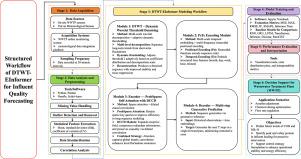基于自适应小波去噪和增强Informer的多步污水水质混合预测模型
IF 6.7
2区 工程技术
Q1 ENGINEERING, CHEMICAL
引用次数: 0
摘要
准确的多步进水水质预测是确保污水处理厂稳定运行和符合法规要求的关键。然而,现有模型在传感器噪声抑制、时间依赖性建模以及同时捕获全球趋势和局部波动方面存在困难,限制了其预测准确性和稳健性。为了解决这些挑战,我们提出了动态阈值小波变换增强信息器(DTWT-EInformer),这是一种将DTWT与EInformer架构集成在一起的混合框架。DTWT采用电平感知阈值自适应滤波非平稳噪声,同时保留关键信号特征。EInformer结合了位置和时间编码、ProbSparse自关注和扩展因果卷积蒸馏,以共同捕获时间因果约束下的长期依赖关系和短期波动。该模型使用中国延安一个全面污水处理厂1年监测活动中以30分钟分辨率收集的进水水质和气象数据集进行了训练和验证。目标变量为化学需氧量(COD)和氨氮(NH3-N),预测范围为提前5 ~ 45步(2.5 ~ 22.5 h)。实验结果表明,与基线模型相比,DTWT-EInformer将均方误差(MSE)和根误差(RMSE)降低了90%以上,实现了0.9976 (COD)和0.9986 (NH3-N)的R2值,并将对称平均绝对百分比误差(SMAPE)保持在1%以下。平均推理时间为291-302 ms,证明了其适合于WWTP操作中的实时部署。本文章由计算机程序翻译,如有差异,请以英文原文为准。

Hybrid prediction model for multi-step wastewater influent quality using adaptive wavelet denoising and enhanced Informer
Accurate multi-step influent quality forecasting is essential for ensuring the stable operation and regulatory compliance of wastewater treatment plants (WWTPs). However, existing models struggle with sensor noise suppression, temporal dependency modelling, and the simultaneous capture of global trends and local fluctuations, limiting their predictive accuracy and robustness. To address these challenges, we propose Dynamic Thresholding Wavelet Transform-enhanced Informer (DTWT-EInformer), a hybrid framework that integrates DTWT with an EInformer architecture. The DTWT adaptively filters non-stationary noise using level-aware thresholds while preserving key signal features. The EInformer incorporates positional and temporal encoding, ProbSparse self-attention, and Dilated Causal Convolution Distillation to jointly capture long-term dependencies and short-term fluctuations under temporal causality constraints. The model was trained and validated using influent water quality and meteorological datasets collected at 30-min resolution over a 1-year monitoring campaign from a full-scale WWTP in Yan’an, China. The target variables were chemical oxygen demand (COD) and ammonia nitrogen (NH-N), with forecast horizons ranging from 5–45 steps ahead (2.5–22.5 h). The experimental results showed that DTWT-EInformer reduced the mean squared error (MSE) and root MSE (RMSE) by over 90% relative to baseline models, achieved values of 0.9976 (COD) and 0.9986 (NH-N), and maintained symmetric mean absolute percentage error (SMAPE) below 1%. The average inference time of 291–302 ms demonstrated its suitability for real-time deployment in WWTP operations.
求助全文
通过发布文献求助,成功后即可免费获取论文全文。
去求助
来源期刊

Journal of water process engineering
Biochemistry, Genetics and Molecular Biology-Biotechnology
CiteScore
10.70
自引率
8.60%
发文量
846
审稿时长
24 days
期刊介绍:
The Journal of Water Process Engineering aims to publish refereed, high-quality research papers with significant novelty and impact in all areas of the engineering of water and wastewater processing . Papers on advanced and novel treatment processes and technologies are particularly welcome. The Journal considers papers in areas such as nanotechnology and biotechnology applications in water, novel oxidation and separation processes, membrane processes (except those for desalination) , catalytic processes for the removal of water contaminants, sustainable processes, water reuse and recycling, water use and wastewater minimization, integrated/hybrid technology, process modeling of water treatment and novel treatment processes. Submissions on the subject of adsorbents, including standard measurements of adsorption kinetics and equilibrium will only be considered if there is a genuine case for novelty and contribution, for example highly novel, sustainable adsorbents and their use: papers on activated carbon-type materials derived from natural matter, or surfactant-modified clays and related minerals, would not fulfil this criterion. The Journal particularly welcomes contributions involving environmentally, economically and socially sustainable technology for water treatment, including those which are energy-efficient, with minimal or no chemical consumption, and capable of water recycling and reuse that minimizes the direct disposal of wastewater to the aquatic environment. Papers that describe novel ideas for solving issues related to water quality and availability are also welcome, as are those that show the transfer of techniques from other disciplines. The Journal will consider papers dealing with processes for various water matrices including drinking water (except desalination), domestic, urban and industrial wastewaters, in addition to their residues. It is expected that the journal will be of particular relevance to chemical and process engineers working in the field. The Journal welcomes Full Text papers, Short Communications, State-of-the-Art Reviews and Letters to Editors and Case Studies
 求助内容:
求助内容: 应助结果提醒方式:
应助结果提醒方式:


